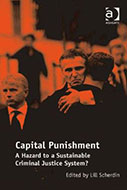Capital Punishment: A Hazard to a Sustainable Criminal Justice System?

Editor: Lill Scherdin
Publisher: Farnham, Surrey, UK; Burlington, VT: Ashgate Publishing, 2014. 344p.
Reviewer: James R. Acker | November 2014
Lill Scherdin, a senior researcher at the Department of Criminology and Sociology of Law, University of Oslo, is editor of this volume, comprising 15 chapters authored by scholars, activists, and governmental officials from around the world. Contributors examine the capital punishment systems of several countries, including the United States, Japan, South Korea, Taiwan, China, India, Morocco, and Indonesia. Other chapters focus more generally on worldwide trends regarding the legal status and actual use of capital punishment, and the varying functions served by the death penalty over time and within diverse cultures. The book is avowedly abolitionist in its orientation. Indeed, it is puzzling why the title, Capital Punishment: A Hazard to a Sustainable Criminal Justice System?, culminates in a question mark. Several of the contributors unapologetically presume that universal repudiation of the death penalty is long overdue and would make the world a better place.
The volume begins with the moving Foreword by Knut Storberget, Norway’s Minister of Justice in July 2011 when a Norwegian anti-Muslim, anti-immigration extremist detonated a bomb that destroyed the Prime Minister’s Office and the Ministry of Justice, killing eight people. The man then gunned down 69 young people who had gathered on an island for the Labor Party Youth League’s summer camp. Norway had purged capital punishment from its penal code more than a half century earlier—in 1950—and its last execution for an “ordinary” crime occurred in 1876 (one execution took place in 1948 in response to World War II atrocities). The maximum punishment allowed in response to the 2011 mass killings was 21 years imprisonment, subject to later periods of confinement in the name of preventive detention if justified. Rather than decrying the absence of capital punishment for these depraved and horrific murders, and being dominated “by irrational feelings of revenge and retribution,” the people of Norway grew ever closer, resolute that “as far as possible, sanctions must seek to repair damage, foster reconciliation, and lay the ground for a future life in the community” (p. xviii). The former Minister of Justice hailed his country’s commitment to policies that center on prevention and rehabilitation, assailed resort to the death penalty “as a pretext for doing nothing” (id.) about crime and its contributing factors, and insisted that “[w]hatever the situation, the taking of human life is unacceptable. Life is inviolable. End of story” (p. xix).
Fellow Norwegians Lill Scherdin and Nils Christie (Emeritus Professor at the University of Oslo) echo and expand on these sentiments in their respective chapters. Scherdin roots nations’ differing punishment policies in the structural conditions endemic to their societies. Countries rife with social and economic inequality spawn the process of “othering,” through which discrete classes of people are perceived as separate and distinct from other citizens, resulting in their marginalization rather than sharing full membership in the human community. These conditions help precipitate government by punishment. Within this framework, the death penalty becomes a tool used by elites and the politically powerful to quell fear of crime, maintain boundaries, and promote social stability. Scherdin argues that capital punishment threatens the sustainability of systems of criminal justice, meaning the capability “to meet the needs of today . . . without compromising the needs of future generations” (p. 53). “[T]he death penalty’s unique mesmerizing force weakens a society’s ability to focus politically on evaluating harms and threats as well as the different measures that could be taken against them” (p. 54). Beyond that, it affirmatively causes collateral damage to families, communities, and a society’s ethical core. Christie’s thesis is similar. “The penal system of a country creates a mirror of that society. It tells us who we are” (p. 70). Societies fragmented by social distance and a lack of shared community are a breeding ground for repressive penal policies including capital punishment and long term incarceration. He yearns for the time when “old-fashioned villages, or stable and long-established quarters within cities” reigned. “These were places where inhabitants saw each other, knew each other, and were also able to some extent both to help and to control each other. When they disappear, deviance is converted into crime and social control becomes a task for officials” (p. 74). Christie views these trends as lamentable. In most extreme form, they result in capital punishment, which, in his view, is never a solution. Nor is imprisonment an appealing alternative. Rather than being organized to inflict pain, he urges, justice systems should be restorative, allowing offenders, victims, and communities to join in crafting constructive responses to individual and social harms.
David Garland, Professor of Sociology at New York University, elsewhere has written insightfully about the social conditions that explain why the United States is alone among developed Western democracies in retaining capital punishment (Garland, 2010). His chapter employs a broad sociological brush to account for the dominant trend toward abolition in Western countries. As societies mature, capital punishment becomes increasingly irrelevant to sovereign states for demonstrating and affirming their political authority, its original justification. In time, and with the availability of long-term imprisonment and other alternative sanctions, it also ceases to be a necessary or even useful instrument of crime control. Stripped of these functions, government-sponsored executions are transformed into a human rights issue, representing a tool of repression and an inhumane punishment in violation of fundamental dignity.
The United States, of course, is an anomaly. Two chapters in the book, one by Baltimore Law School Professor John Bessler and the other by Indiana University Law School Professor Jody Madeira, focus on the United States and its capital punishment policies, although neither addresses this country’s exceptionalism. They instead develop or expand on themes they have successfully explored before: Bessler on the ambivalent views about the death penalty maintained by many of the framers of the United States Constitution and other prominent Americans of that era (Bessler, 2012), and Madeira on whether executions offer welcome “closure” to murder victims’ survivors (Madeira, 2012).
These chapters are interesting. But like many of the other chapters in the book, particularly those in the principal sections which describe death penalty developments within select Asian countries and countries with majority Muslim populations, they only tangentially (at best) touch upon the issues capsuled in the book’s title and in its announced “central questions.” As defined in the editor’s introduction, those questions include: “What are the historical, economic, political and cultural conditions making governance without the death penalty possible? Furthermore, what are the necessary conditions for a criminal justice system without the death penalty to be sustainable over time? Or should the question be whether a criminal justice system with the death penalty can be sustainable in the world today . . . ? Can the death penalty itself be a hazard to a sustainable criminal justice system?” (p. 1).
Perhaps ironically, the principal weakness of this collection lies in the latitude given authors to write chapters so loosely tethered to the book’s promised unifying thesis. With the exception of the chapters written by Scherdin, Christie, and Garland in the volume’s first part (“Governance and the Death Penalty”) and the two chapters written by Vidar Halvorsen and Roger Hood in its final part (“Reflection and Outlook”), the contributions by and large are a scattered mix of idiosyncratic perspectives about capital punishment, descriptions of death-penalty laws and practices within various countries and cultural traditions, and paeans for the abolition of this ultimate form of punishment.
In this latter category, for example, consider the impassioned commentary of Syrian imam and Professor (at Abu Dhabi University) Mohammad Habash, whose chapter begins: “For the sake of bringing humanity to the wells of peace and compassion, and stopping all forms of abuse of human physical integrity and dignity, it is important to eradicate laws that give the judiciary the power to kill people because of their political affiliations and/or criminal activities” (p. 231). His thoughtful essay thereafter attempts to persuade that Islamic justice does not demand punishment by death. To the contrary, he argues, the abolition of capital punishment is consistent with, if it is not demanded by, adherence to basic elements of Islamic jurisprudence. The overview offered by Moroccan attorney and law professor Mohammed Ayatt of the death penalty in Morocco begins with similar certitude about the wrongfulness of the practice. “I would like to state upfront that I oppose the death penalty. Like most abolitionists I oppose it because of its uselessness, its cruelty, its irreversible and irremediable character . . . , its very often discriminatory enforcement on the poor and on minorities and last, but not least, because of the frequent misuse of the death penalty by dictators” (p. 239). While such declarations are refreshingly honest, they unfortunately are unlikely to commend the volume to the many prospective readers who support or who have less solidified misgivings about capital punishment—those readers who, in other words, these authors would presumably hope most fervently to reach so they would consider seriously what they have to say.
The volume has compensating strengths. Many of the contributors artfully position the death penalty debate in deep-seated cultural, political, religious, and historical contexts, thereby convincingly shifting the perspective toward the human rights dimension of state-sponsored executions and away from the death penalty’s nominal function as an instrument of crime control. The chapter contributed by University of Oslo Professor Vidar Halvorsen, “Criminal Justice, Sustainability, and the Death Penalty,” directly addresses the issues heralded by the book’s title and in the process makes use of a compelling and memorable metaphor. He invokes the description contained in Homer’s The Odyssey of Ulysses ordering his crew to place wax in their ears and then to bind him to the mast of his ship so he can listen to the alluring songs of the sirens, which are so seductively distracting that they almost certainly would cause a ship’s captain hearing them to veer into the dangerous shoals of the narrow sea passage that demands careful navigation. Halvorsen continues: “It is easy to understand why this poetic story of Homer . . . has become an effective illustration of the main idea of constitutionalism. Like Ulysses, citizens of states hope to be able to navigate their societies through political temptations by binding themselves to a constitution, a set of legal pre-commitments that can only be changed by more demanding procedures. Ulysses’ story illustrates, moreover, a basic virtue of constitutional self-binding: by restricting their power by self-imposed constraints, citizens are able to expand it in the sense that they can now achieve by indirect means objectives they would be unable to achieve in a direct manner” (p. 282).
The import of this teaching to death-penalty issues, and in particular to whether capital punishment is a hazard to sustainable systems of criminal justice, needs no elaboration. And if this edited volume succeeds only in illuminating the core argument associated with this provocative imagery, it will have made an important contribution to the international debate concerning the abolition or retention of the death penalty as an instrument of criminal and political justice.
James R. Acker is a Distinguished Teaching Professor in the School of Criminal Justice, University at Albany.
References
Bessler, John D. (2012). Cruel & Unusual: The American Death Penalty and the Founders’ Eighth Amendment. Boston: Northeastern University Press.
Garland, David (2010). Peculiar Institution: America’s Death Penalty in an Age of Abolition. Cambridge, MA: Belknap Press of Harvard University Press.
Madeira, Jody Lynee (2012). Killing McVeigh: The Death Penalty and the Myth of Closure. New York: New York University Press.


